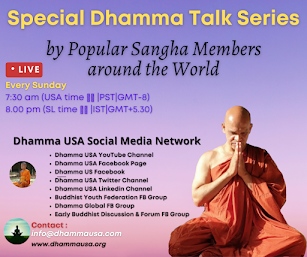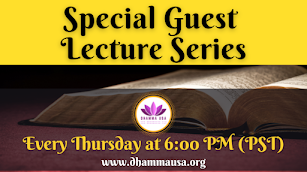Assayuja Uposatha: The Culmination of Vassa and the Great Descent
By Bhante Sumitta
The Assayuja full moon marks one of the most spiritually significant observances in the Buddhist calendar, commemorating two extraordinary events that demonstrate the Buddha's compassionate wisdom and the profound depths of the Abhidhamma teaching.
The Ascent to Tāvatiṃsa
According to the commentarial tradition, during the seventh Vassa after his Enlightenment, the Buddha ascended to the Tāvatiṃsa heaven realm to teach the Abhidhamma to his mother, Mahā Māyādevī, who had been reborn there as a deva. This act of filial gratitude reflects a beautiful dimension of the Buddha's character—that even after attaining supreme enlightenment, he honored the debt owed to his mother by offering her the gift of Dhamma.
For three months during the rainy season retreat, the Buddha remained in Tāvatiṃsa, expounding the Abhidhamma Piṭaka in its entirety. The celestial assembly included not only his mother but also Sakka (Indra) and countless devas who received these profound teachings on the ultimate nature of reality. Meanwhile, the Buddha would return daily at noon to the human realm to take his meal and provide a summary of the teachings to Venerable Sāriputta, who would later systematize and preserve these teachings for the Saṅgha.
The Nature of Abhidhamma
The Abhidhamma represents the highest expression of the Buddha's analytical wisdom. While the Sutta Piṭaka teaches through conventional language and relatable circumstances, the Abhidhamma dismantles phenomena into their ultimate constituents—exposing the impermanent, conditioned nature of all compounded things. Through categories such as cittas (consciousness moments), cetasikas (mental factors), and rūpas (material phenomena), it reveals the mechanical precision of dependent origination and the absence of any permanent self.
This teaching is particularly fitting for celestial beings whose refined mental states can grasp such subtle discriminations. Yet it also serves as the foundation for deep vipassanā practice, training the mind to see beyond conceptual formations to the bare reality of rising and passing phenomena.
Mahā Pavāraṇā and the Descent at Saṅkassa
On the Assayuja full moon, the Buddha descended from Tāvatiṃsa to the city of Saṅkassa (in present-day Uttar Pradesh). The commentaries describe a magnificent triple staircase manifesting—one of gold, one of silver, and one of jewels—as the Buddha, accompanied by Sakka, Brahmā, and innumerable devas, returned to the human realm.
This descent coincided with the Pavāraṇā ceremony marking the conclusion of Vassa. Kings and multitudes gathered to witness this miraculous event, and the Buddha's return symbolized the completion of a sacred duty and the continuation of his mission to teach all beings.
The Spiritual Significance for Practice
For contemporary practitioners, Assayuja Uposatha invites several contemplations:
Gratitude and Generosity: The Buddha's teaching to his mother exemplifies kataññutā-katavedī—gratitude and reciprocation. We reflect on our own debts to parents, teachers, and benefactors, seeking ways to repay kindness through Dhamma practice and service.
The Value of Abhidhamma Study: While the analytical teachings may seem abstract, they serve as a microscope for examining our moment-to-moment experience. Understanding the conditioned nature of mental and physical phenomena undermines attachment and supports the direct seeing of anattā.
Completion and Renewal: As Vassa concludes with Pavāraṇā, we have the opportunity to reflect on our spiritual progress during the rains retreat, to invite correction from our fellow practitioners, and to renew our commitment to the training for the months ahead.
Accessibility of the Dhamma: The Buddha's descent represents the constant return of transcendent wisdom to the conventional world. The highest teachings are not kept in rarified realms but are made available to all who sincerely seek liberation.
Observance
Many monasteries and communities mark this day with special Uposatha observances, Abhidhamma chanting, and offerings. Lay supporters may take the Eight Precepts, engage in extended meditation, and make offerings to the Saṅgha as Pavāraṇā concludes and the Kathina season begins.
As we commemorate the Buddha's teaching in Tāvatiṃsa and his compassionate return to guide human beings, we renew our aspiration to penetrate the Dhamma as deeply as our faculties allow, and to share whatever understanding we gain for the welfare of all beings.
Sādhu, Sādhu, Sādhu.






























0 comments:
Post a Comment
Your comments and feedback are very helpful to us in improving our posts. We really appreciate your time. Thank you!
Dhamma USA Team.